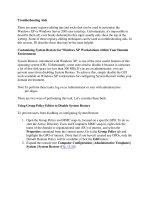Tài liệu Fast Fourier Transform part 1 doc
Bạn đang xem bản rút gọn của tài liệu. Xem và tải ngay bản đầy đủ của tài liệu tại đây (82.75 KB, 5 trang )
Sample page from NUMERICAL RECIPES IN C: THE ART OF SCIENTIFIC COMPUTING (ISBN 0-521-43108-5)
Copyright (C) 1988-1992 by Cambridge University Press.Programs Copyright (C) 1988-1992 by Numerical Recipes Software.
Permission is granted for internet users to make one paper copy for their own personal use. Further reproduction, or any copying of machine-
readable files (including this one) to any servercomputer, is strictly prohibited. To order Numerical Recipes books,diskettes, or CDROMs
visit website or call 1-800-872-7423 (North America only),or send email to (outside North America).
Chapter 12. Fast Fourier Transform
12.0 Introduction
A very large class of important computational problems falls under the general
rubric of “Fourier transform methods” or “spectral methods.” For some of these
problems, the Fourier transform is simply an efficient computational tool for
accomplishing certain common manipulations of data. In other cases, we have
problems for which the Fourier transform (or the related “power spectrum”) is itself
of intrinsic interest. These two kinds of problems share a common methodology.
Largely for historical reasons the literature on Fourier and spectral methods has
been disjointfrom the literatureon “classical” numerical analysis. Nowadays there is
no justificationfor such a split. Fouriermethods arecommonplace in research andwe
shall not treat them as specialized or arcane. At the same time, we realize that many
computer users have had relatively less experience with this field than with, say,
differential equations or numerical integration. Therefore our summary of analytical
results will be more complete. Numerical algorithms, per se, begin in §12.2. Various
applications of Fourier transform methods are discussed in Chapter 13.
A physical process can be described either in the time domain, by the values of
some quantity h as a function of time t, e.g., h(t),orelseinthefrequency domain,
where the process is specified by giving its amplitude H (generally a complex
number indicating phase also) as a function of frequency f,thatisH(f), with
−∞ <f <∞. For many purposes it is useful to think of h(t) and H(f) as being
two different representations of the same function. One goes back and forth between
these two representations by means of the Fourier transform equations,
H(f)=
∞
−∞
h(t)e
2πift
dt
h(t)=
∞
−∞
H(f)e
−2πift
df
( 12.0.1)
If t is measured in seconds, then f in equation (12.0.1) is in cycles per second,
or Hertz (the unit of frequency). However, the equations work with other units too.
If h is a functionof positionx (in meters), H willbea functionof inversewavelength
(cycles per meter), and so on. If you are trained as a physicist or mathematician, you
are probably more used to using angular frequency ω, which is given in radians per
sec. The relation between ω and f, H(ω) and H(f) is
ω ≡ 2πf H(ω) ≡ [H(f)]
f=ω/2π
(12.0.2)
496
12.0 Introduction
497
Sample page from NUMERICAL RECIPES IN C: THE ART OF SCIENTIFIC COMPUTING (ISBN 0-521-43108-5)
Copyright (C) 1988-1992 by Cambridge University Press.Programs Copyright (C) 1988-1992 by Numerical Recipes Software.
Permission is granted for internet users to make one paper copy for their own personal use. Further reproduction, or any copying of machine-
readable files (including this one) to any servercomputer, is strictly prohibited. To order Numerical Recipes books,diskettes, or CDROMs
visit website or call 1-800-872-7423 (North America only),or send email to (outside North America).
and equation (12.0.1) looks like this
H(ω)=
∞
−∞
h(t)e
iωt
dt
h(t)=
1
2π
∞
−∞
H(ω)e
−iωt
dω
(12.0.3)
We were raised on the ω-convention, but we changed! There are fewer factors of
2π to remember if you use the f-convention, especially when we get to discretely
sampled data in §12.1.
From equation (12.0.1) it is evident at once that Fourier transformation is a
linear operation. The transform of the sum of two functions is equal to the sum of
the transforms. The transform of a constant times a function is that same constant
times the transform of the function.
In the time domain, function h(t) may happen to have one or more special
symmetries It might be purely real or purely imaginary or it might be even,
h(t)=h(−t),orodd, h(t)=−h(−t). In the frequency domain, these symmetries
lead to relationships between H(f) and H(−f). The following table gives the
correspondence between symmetries in the two domains:
If then
h(t)is real H(−f)=[H(f)]*
h(t) is imaginary H(−f)=−[H(f)]*
h(t) is even H(−f)=H(f) [i.e., H(f) is even]
h(t) is odd H(−f)=−H(f) [i.e., H(f) is odd]
h(t) is real and even H(f) is real and even
h(t) is real and odd H(f) is imaginary and odd
h(t) is imaginary and even H(f) is imaginary and even
h(t) is imaginary and odd H(f) is real and odd
In subsequent sections we shall see how to use these symmetries to increase
computational efficiency.
Here are some other elementary properties of the Fourier transform. (We’ll use
the “⇐⇒ ” symbol to indicate transform pairs.) If
h(t) ⇐⇒ H ( f )
is such a pair, then other transform pairs are
h(at) ⇐⇒
1
| a |
H (
f
a
) “time scaling” (12.0.4)
1
|b|
h(
t
b
) ⇐⇒ H ( bf) “frequency scaling” (12.0.5)
h(t − t
0
) ⇐⇒ H ( f ) e
2 πift
0
“time shifting” (12.0.6)
h(t) e
−2πif
0
t
⇐⇒ H ( f − f
0
) “frequency shifting” (12.0.7)
498
Chapter 12. Fast Fourier Transform
Sample page from NUMERICAL RECIPES IN C: THE ART OF SCIENTIFIC COMPUTING (ISBN 0-521-43108-5)
Copyright (C) 1988-1992 by Cambridge University Press.Programs Copyright (C) 1988-1992 by Numerical Recipes Software.
Permission is granted for internet users to make one paper copy for their own personal use. Further reproduction, or any copying of machine-
readable files (including this one) to any servercomputer, is strictly prohibited. To order Numerical Recipes books,diskettes, or CDROMs
visit website or call 1-800-872-7423 (North America only),or send email to (outside North America).
With two functions h(t) and g(t), and their corresponding Fourier transforms
H(f) and G(f), we can form two combinations of special interest. The convolution
of the two functions, denoted g ∗ h,isdefinedby
g∗h≡
∞
−∞
g(τ)h(t − τ) dτ (12.0.8)
Note that g ∗ h is a function in the time domain and that g ∗ h = h ∗ g. It turns out
that the function g ∗ h is one member of a simple transform pair
g ∗ h ⇐⇒ G ( f ) H ( f ) “ConvolutionTheorem” (12.0.9)
In other words, the Fourier transform of the convolution is just the product of the
individual Fourier transforms.
The correlation of two functions, denoted Corr(g, h),isdefinedby
Corr(g, h) ≡
∞
−∞
g(τ + t)h(τ) dτ (12.0.10)
The correlation is a function of t, which is called the lag. It therefore lies in the time
domain, and it turns out to be one member of the transform pair:
Corr(g, h) ⇐⇒ G ( f ) H *(f) “Correlation Theorem” (12.0.11)
[More generally, the second member of the pair is G(f)H(−f), but weare restricting
ourselves to the usual case in whichg and h are real functions,so wetakethelibertyof
setting H(−f)=H*(f).] This result shows that multiplyingthe Fourier transform
of one function by the complex conjugate of the Fourier transform of the other gives
the Fourier transform of their correlation. The correlation of a function with itself is
called its autocorrelation. In this case (12.0.11) becomes the transform pair
Corr(g, g) ⇐⇒ | G ( f ) |
2
“Wiener-Khinchin Theorem” (12.0.12)
The total power in a signal is the same whether we compute it in the time
domain or in the frequency domain. This result is known as Parseval’s theorem:
Total Power ≡
∞
−∞
|h(t)|
2
dt =
∞
−∞
|H(f)|
2
df ( 12.0.13)
Frequently one wants to know “how much power” is contained in the frequency
interval between f and f + df . In such circumstances one does not usually
distinguish between positive and negative f, but rather regards f as varying from 0
(“zero frequency” or D.C.) to +∞. In such cases, one defines the one-sided power
spectral density (PSD) of the function h as
P
h
(f) ≡|H(f)|
2
+|H(−f)|
2
0≤f<∞ (12.0.14)
so that the total power is just the integral of P
h
(f) from f =0to f = ∞. When the
functionh(t) is real, thenthetwoterms in (12.0.14) are equal, soP
h
(f)=2|H(f)|
2
.
12.0 Introduction
499
Sample page from NUMERICAL RECIPES IN C: THE ART OF SCIENTIFIC COMPUTING (ISBN 0-521-43108-5)
Copyright (C) 1988-1992 by Cambridge University Press.Programs Copyright (C) 1988-1992 by Numerical Recipes Software.
Permission is granted for internet users to make one paper copy for their own personal use. Further reproduction, or any copying of machine-
readable files (including this one) to any servercomputer, is strictly prohibited. To order Numerical Recipes books,diskettes, or CDROMs
visit website or call 1-800-872-7423 (North America only),or send email to (outside North America).
h(t)
2
(a)
(b)
(c)
f
P
h
( f ) (one-sided)
0−f
P
h
( f )
(two-sided)
t
f0
Figure 12.0.1. Normalizations of one- and two-sided power spectra. The area under the square of the
function, (a), equals the area under its one-sided power spectrum at positive frequencies, (b), and also
equals the area under its two-sided power spectrum at positive and negative frequencies, (c).
Be warned that one occasionally sees PSDs defined without this factor two. These,
strictly speaking, are called two-sided power spectral densities, but some books
are not careful about stating whether one- or two-sided is to be assumed. We
will always use the one-sided density given by equation (12.0.14). Figure 12.0.1
contrasts the two conventions.
If the function h(t) goes endlessly from −∞ <t<∞, then its total power
and power spectral density will, in general, be infinite. Of interest then is the (one-
or two-sided) power spectral density per unit time. This is computed by taking a
long, but finite, stretch of the function h(t), computing its PSD [that is, the PSD
of a function that equals h(t) in the finite stretch but is zero everywhere else], and
then dividingthe resulting PSD by the length of the stretch used. Parseval’s theorem
in this case states that the integral of the one-sided PSD-per-unit-time over positive
frequency is equal to the mean square amplitude of the signal h(t).
You might well worry about how the PSD-per-unit-time, which is a function
of frequency f, converges as one evaluates it using longer and longer stretches of
data. This interesting question is the content of the subject of “power spectrum
estimation,” and will be considered below in §13.4–§13.7. A crude answer for
500
Chapter 12. Fast Fourier Transform
Sample page from NUMERICAL RECIPES IN C: THE ART OF SCIENTIFIC COMPUTING (ISBN 0-521-43108-5)
Copyright (C) 1988-1992 by Cambridge University Press.Programs Copyright (C) 1988-1992 by Numerical Recipes Software.
Permission is granted for internet users to make one paper copy for their own personal use. Further reproduction, or any copying of machine-
readable files (including this one) to any servercomputer, is strictly prohibited. To order Numerical Recipes books,diskettes, or CDROMs
visit website or call 1-800-872-7423 (North America only),or send email to (outside North America).
now is: The PSD-per-unit-time converges to finite values at all frequencies except
those where h(t) has a discrete sine-wave (or cosine-wave) component of finite
amplitude. At those frequencies, it becomes a delta-function, i.e., a sharp spike,
whose width gets narrower and narrower, but whose area converges to be the mean
square amplitude of the discrete sine or cosine component at that frequency.
We have by now stated all of the analytical formalism that we will need in this
chapter with one exception: In computational work, especially with experimental
data, we are almost never given a continuous function h(t) to work with, but are
given, rather, a list of measurements of h(t
i
) for a discrete set of t
i
’s. The profound
implications of this seemingly unimportant fact are the subject of the next section.
CITED REFERENCES AND FURTHER READING:
Champeney, D.C. 1973,
Fourier Transforms and Their Physical Applications
(New York: Aca-
demic Press).
Elliott, D.F., and Rao, K.R. 1982,
Fast Transforms: Algorithms, Analyses, Applications
(New
York: Academic Press).
12.1 Fourier Transform of Discretely Sampled
Data
In the most common situations, function h(t) is sampled (i.e., its value is
recorded) at evenly spaced intervals in time. Let ∆ denote the time interval between
consecutive samples, so that the sequence of sampled values is
h
n
= h(n∆) n = ,−3,−2,−1,0,1,2,3, (12.1.1)
The reciprocal of the time interval ∆ is called the sampling rate;if∆is measured
in seconds, for example, then the sampling rate is the number of samples recorded
per second.
Sampling Theorem and Aliasing
For any sampling interval ∆, there is also a special frequency f
c
, called the
Nyquist critical frequency,givenby
f
c
≡
1
2∆
(12.1.2)
If a sine wave of the Nyquist critical frequency is sampled at its positivepeak value,
then the next sample will be at its negative trough value, the sample after that at
the positive peak again, and so on. Expressed otherwise: Critical sampling of a
sine wave is two sample points per cycle. One frequently chooses to measure time
in units of the sampling interval ∆. In this case the Nyquist critical frequency is
just the constant 1/2.
The Nyquistcritical frequency is importantfor two related, but distinct,reasons.
One is good news, and the other bad news. First the good news. It is the remarkable









